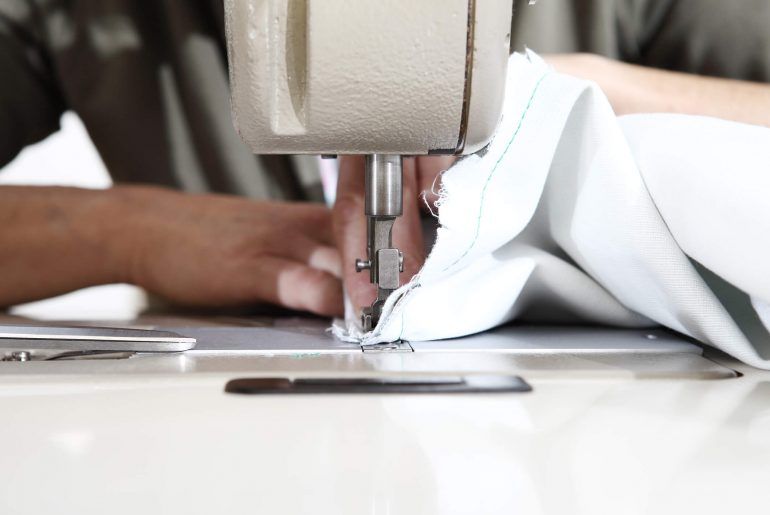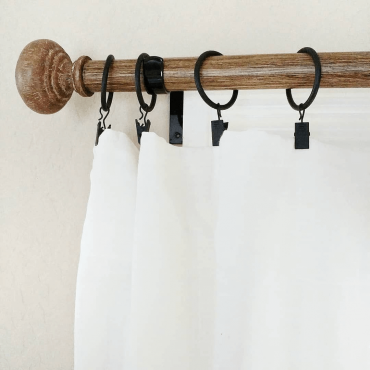How to Hem Curtains: Quick and Easy Methods

After hours of browsing online and looking at textiles at the store, you’ve finally found the perfect pair of curtains for your home!
There’s just one small issue. Your new curtains are too long and need to be shortened to accommodate your windows perfectly.
Luckily, hemming your curtains at home is easier than you think. You don’t have to break the bank getting your curtains tailored by a professional.
We’ve put together a comprehensive step-by-step guide to help you hem your curtains to the perfect length for your windows.
Discover more tips on how to hang curtains effortlessly.
Why Should You Hem Your Curtains?
Ready-made curtains come in a few standard lengths (typically 63, 84, 95, 108 or 120 inches). Unfortunately, windows do not always accommodate these measurements.
However, tailoring curtains isn’t just for style. Hemming also prevents the fabric from drooping on the floor, fraying and posing a tripping hazard. That’s why it’s essential to hem your curtains to fit your windows properly.
Curious about curtain lengths? Learn more about curtain length rules.
With a few measurements and materials, you can have perfect length curtains in no time. But before starting any of these hemming methods, make sure your curtains are ready first.
Some fabrics shrink after laundering, so check the care label on your curtains if you plan to wash them often. If your curtains are prone to shrinkage, launder them before measuring and hanging.
Next, iron your curtains to remove any creases or wrinkles that will prevent them from hanging straight.
Below we’ve outlined our favorite sew, no-sew and tape methods for hemming curtains.
How to Hem Curtains: Sewing Method
Learn how to hem curtains by sewing in seven easy steps.
Here’s what you’ll need:
- Tape measure or yardstick
- Iron
- Ironing board or large flat, padded surface
- Straight pins
- Fabric scissors
- Sewing machine or hand-sewing needle
- Thread to match your curtains
Step 1: Hang Curtains
First, find the optimal length for your curtains by hanging them in the desired window of your home.
Hanging curtains can take time, but know that you don’t have to settle for traditional curtain hardware that requires nails, screws, measuring and drilling.
Kwik-Hang makes damage-free curtain rod brackets that help you hang your curtains fast in just three easy steps. Simply align Kwik-Hang’s brackets to your window trim, tap them in place and insert your curtain rod and panels to determine how much hemming you need to do.
Step 2: Pull Curtains
After putting up your curtains, make sure they hang straight with no creases.
Pull the fabric gently towards the floor to see the exact length. Be careful not to stretch it too tightly. It’s crucial to observe how much excess material you have so you can hem your curtains accurately.
Step 3: Pin Curtains
Now, place straight pins where you would like to hem the curtains. But first, decide if you want your curtains to float, kiss or puddle on the floor:
- Float: The curtains “float” less than one inch above the floor. A good option if you want your curtains to hang straight down without a break.
- Kiss: The curtains graze the floor. This style is challenging to hang correctly, as it requires precise measurements. Remember to accommodate for the length of the curtain rods and curtain rings (if any) you’re using.
- Puddle: Longer curtains that flare out on the floor. This style is romantic, feminine and old-world, ideal for drapery in formal rooms. Use high-quality, thick fabric like velvet or linen.
How wide should a curtain hem be? Always allow for a double-folded hem. This prevents the rough fabric edge from showing when you cut your curtains and creates a neat and clean appearance.
Longer curtains need longer hems and shorter curtains need shorter hems to look proportional:
- Standard floor-length curtains should have a three to four-inch hem, plus another three to four inches for the double fold. Your curtains should then be six to eight inches longer than where you place your pins.
- Apron-length curtains should have a two-inch hem plus allowance for the double fold, so add four inches to your curtain length.
Example: Let’s say your window needs 84-inch curtains, but you found curtains you love that are only available in a 96-inch length. Don’t automatically cut off 12 inches! Here’s what the calculation would look like to shorten your curtains:
- 96-inch curtain
- Subtract 3 inches for the hem
- Subtract 3 inches for the double fold
- = 6 inches required for the hem and double fold
- 96 – 6 = 90 inches required
- Cut off 6 inches
Pro-tip: Unless your curtains are longer than they should be, consider hemming instead of cutting. If you make a mistake or decide to use the curtains in another room, you can undo the hem and re-hem them to the size you need.
Step 4: Measure Length for Sewing
Use your tape measure or yardstick to ensure that the straight pins align evenly.
Keep in mind that most floors aren’t perfectly leveled, so double-check measurements and straightness.
Step 5: Fold and Iron Hem
Next, fold and iron twice: once for the double-fold and once for the hem. Fold the fabric evenly for the double-fold and pin into place. Make sure to fold back toward the wrong side of the curtain. Iron the double-fold firmly.
Then, fold the curtain along the original pin line for the hem. Use the straight pins to continue to hold the hem in place. Iron across, slowly and firmly to secure the fold of the hem. You can remove the straight pins once you finish ironing.
Step 6: Sew Curtains
You can sew by hand or use a sewing machine to secure the newly measured hem on your curtains. Aim to sew as close to the double-folded edge as possible.
Step 7: Rehang Curtains
Once you sew the hem, it’s time to rehang the finished product. Give the curtains another quick press with your iron before putting them back up.
Check out the best finishing touches to add to your newly tailored curtains.
How to Hem Curtains: No-Sew Methods
Is there an easy way to hem curtains without sewing?
If you don’t own a sewing machine or don’t have time to sew your curtains by hand, there are two no-sew methods you can try: iron-on fusible bonding web or hem tape and glue. For either of these methods, repeat steps 1 through 5 above first.
The disadvantage of these no-sew techniques is that they are difficult (if not impossible) to remove. Consider these to be permanent hemming methods.
Iron-On Fusible Bonding Web and Hem Tape
Using an iron-on fusible bonding web (like Stitch Witchery) is an easy way to hem your curtains without sewing. Fusible tape melts when heated, causing a glue-like effect when you iron it.
Important: Wash your curtains before using any type of fusible product. Finishing agents and sizing in the fabric may prevent the fusible tape from adhering to your curtains.
Here’s how to use hemming tape on curtains:
- Place the tape between the top of your curtain hem and your double fold. Press with a hot iron until the fusible tape melts.
- Allow the tape to cool before moving to the next section, so the fusing has time to adhere completely. Always iron the tape between your fabric layers, not on the tape directly, as it can melt to the iron.
Fabric Glue and Hot Glue
For the ultimate low-tech hemming method, try using glue! You can use either fabric glue (like Liquid Stitch) or hot glue (using a low-temp glue gun) to hem your curtains.
After folding and ironing your curtains, use glue to secure your hem in place of sewing. Keep in mind that glue (especially hot glue) dries quickly. Work in small sections and press to bond for the best results.
Note: If you’re hemming sheer curtains, it’s best to sew instead of using a no-sew method if possible. Fusible web and glue will show through sheer curtains, which isn’t ideal.
Solve Your Curtain Hassles the Kwik Way
Hemming curtains at home can take time, but that doesn’t mean the rest of the curtain-hanging process has to drag on, too.
Kwik-Hang is the easiest, most hassle-free way to hang curtains. Put up your curtains in seconds with the help of Kwik-Hang’s no-drill, damage-free curtain rod brackets and stylish rod collection.
All you need to do is position the brackets to the window frame and tap them into the woodwork gently with a hammer – absolutely no measuring or drilling required!
Kwik-Hang brackets are available in 5/8 or 1-inch widths to accommodate standard curtain rods and double rods. Choose from various color options to match your furniture, textiles or decorating style.
By choosing Kwik-Hang’s easy tap-in brackets, we guarantee you’ll have more time to hem and style your curtains to create a dream home.






